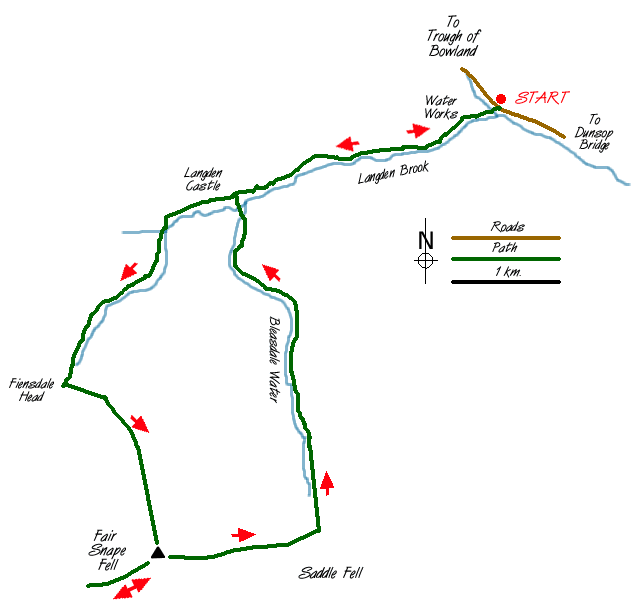Walk 1218 - printer friendly version
Fiensdale Head & Bleasdale Water Walk
Author - Lou Johnson
Length - 10.0 miles / 16.3 km
Ascent - 1265 feet / 383 metres
Grade - moderate
Start - OS grid reference SD632512
Lat 53.955574 + Long -2.5622844
Postcode BB7 3BJ (approx. location only)
This route takes in some wild moorland so it is important that you are competent using a map and compass especially if poor weather is likely to be encountered. Like many areas of the Forest of Bowland the moors visited during this walk are quiet and unspoilt with little chance of other walkers being met for much of the route. It is also worth noting that two river crossings may be impossible after heavy rain so it is best to choose a day after a dry spell. Note - since this route was walked additional fences have appeared and these are not shown on the Ordnance Survey map. It is therefore important that you are confident of your navigational skills especially if low cloud is likely.
The start is near to Sykes Farm on the Trough of Bolwand road a couple of miles west of Dunsop Bridge. It is worth noting that through traffic can now use this road after a series washout has been repaired. Ample parking is available on the grassy verge (Grid ref. SD632512) by the access road to the Langden Brook water Works.
After parking head west through the trees to reach the Water Works continuing on the track that follows the north bank of Langden Brook. Within minutes you will have left civilisation behind and your progress up the valley will be remarkably swift on the undulating route. The first notable landmark is a ruined hut.
Langden castle is in fact not the ruined hut! Approaching from the east it can be found about 100m before the hut where a track joins the path from the right at the top of a small rise just before the descent to the hut. Careful examination of the immediate area will reveal many examples of dressed stone, carved stone and so on that appear to have come from the original.Climbing above the site will give a better idea of layout. (Information supplied by Graham Brown)
Stay on track for a hundred metres past the hut to bear left along a waymarked path. This crosses a boardwalk before descending to the stream. Pick your crossing point with care as the stream is quite deep in places.
The path ahead is clear and climbs steeply across the eastern face of Fiensdale Nab with Fiensdale Wateron your left. This is a very pleasant section of the walk with the path climbing up the side of a deep valley or clough onto the open moorland. It does not look very far on the map but the section alongside Fiensdale Water takes much longer than you think. The path reaches open moorland and crosses a wet and boggy section to reach a fence. this is Fiensdale Head.
Turn left along the fence. The path is clear but is quite wet in places and leads without problem to the summit of Fair Snape Fell which is coincident with a fence junction (grid ref. 597473). The view is disappointing so make the short walk south west along the fence to reach the cairn and trig point (neither of which mark the highest point). From here there are extensive views to the south and west including the distinctive summit of Parlick.
Return to the fence junction and shadow it eastwards for just over one kilometre. You pass a fence junction and shortly afterwards a boundary stone. Ahead lies a shallow col with the crest of Totridge beyond. You now need to turn north to pick up Bleasdale Water and there is a very feint path (grid ref. 613474). However it is feint and extreme care needs to be exercised to ensure you follow the correct route and the only sure way is to find one of the many small stream draining north and follow it downstream as it forms Bleasdale Water. (Note - If you are not confident of finding this path and watercourse then it is safer to follow the route in reverse as navigation is much easier when you head south over this section.)
The path soon becomes clear and follows the east bank of Bleasdale Water, which it accompanies for approximately three kilometres as it descents to Langden Castle. here you need to cross Langden Brook, which can be tricky after rain, to rejoin the track that you used on the outward part of the route. All that remains is to retrace you steps back to the Water Works and the road.

Mountain Weather
Stay safe on the mountains with detailed weather forecasts - for iOS devices or for Android devices.

